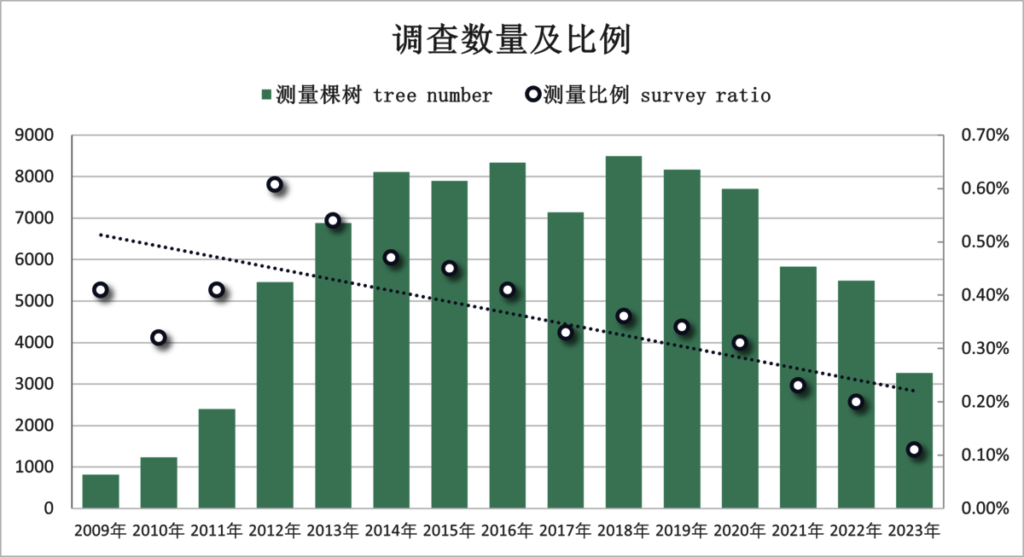By Kai Wang | Forest Manager
During October and November in 2023, MTP team had planed to conduct forest survey in the forest which we planted from 2007 to 2023. But due to the heavy snow, our team had only completed the forest survey in a few forests. The survey, which took 14 days, covered 20 forest plots, 106 sample sites and 3261 sample trees. The survey ratio was 0.11% among total number of the trees planted by MTP.
One part of the forest measured in 2023 was located in Kulun Qi, Tongliao, Inner Mongolia, where preserved the 2007-2012 forest. The other part was located in Horqin Zuoyi Houqi, where preserved the new forest planted from 2020 to 2023.
Forest Basic Information
To date, MTP has successfully planted 2,922,765 trees on 42 forest plots, covering an green area of 39,462.05 Mu in Inner Mongolia. In 2023, two new plots of 1363 Mu and 579.9 Mu were planted. (1 Hectare=15 Mu)
Type of Trees
To date, we’ve planted 8 types of tree species in MTP forests, including 1-year-old and 2-year-old hybrid poplar bare-root seedlings, yellow horn seedlings, maple (Acer Mono) seedlings, 3-year-old container pine tree seedlings, 2-year-old elm seedlings, 1-year-old Caragana Microphylla container seedlings, 2-year-old willow seedlings, 2-year-old Phellodendron amurense seedlings, and 3-year-old spruce seedlings. The survival rate of Caragana Microphylla is too low to collect the data. The number of Phellodendron amurense and spruce is very small and will not be calculated.
Forest Survival Rate
In October and November, MTP team conducted surveys in 20 forest sites, which were planted from 2007 to 2023. The surveys took 14 days in total, covering 106 sample sites and 3261 tree samples. The sampling ratio was 0.11%. The survey measurements included the survival rate, height, basal diameter, diameter at breast height, crown width and spacing in the rows. Based on our survey results, the overall survival rate of all MTP forests in 2023 was 72.98%.
The forest surveyed were mainly planted from 2007 to 2012. For the other unsurveyed forest sites which were planted from 2013 to 2019, the team observed that the trees were growing well on these sites during the regular all-year-around forest visits. Despite that the sample ratio was rather low, the outcomes would not differ much. The survival rates of most forest sites in 2023 were above 60%, which achieved the survival rate goals.
For the poplars and pines in the 2012-4 forest plot, the pines were preserved rather poorly than poplars, which was caused by the frequent inter-planting between pine tree lines. This affected the average survival rate. The survial rates of 2009-1, 2009-2 and 2009-3 forest have always been low because the inappropriate inter-planting. The quality of initial planting of 2023-2 forest was low, accompanied by large-scale grazing, resulting in a low survival rate.
Conclusion
In 2023, the spring in the Tongliao was hot and there were frequent rainfalls in the summer. This climate condition had a negative impact on the new-planted forest, especially on the growth of shrubs. The hot weather from April to May, which caused the roots of new planted seedlings to be burned by high-temperature surface gravel, resulting in a low survival rate. After summer replanting, the survival rate increased a bit, but the overall rate was still not good. However, forests that have been planted for many years were less affected by the climate. The survival rate and density are expected to remain at the current level or slightly decrease.
Project reports on GlobalGiving are posted directly to globalgiving.org by Project Leaders as they are completed, generally every 3-4 months. To protect the integrity of these documents, GlobalGiving does not alter them; therefore you may find some language or formatting issues.
If you donate to this project or have donated to this project, you can recieve an email when this project posts a report. You can also subscribe for reports without donating.
Support this important cause by creating a personalized fundraising page.
Start a Fundraiser


